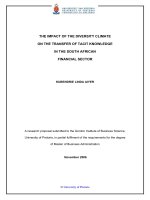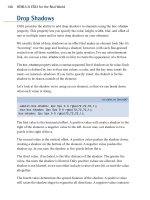GUIDELINES ON QUALITY CONTROL CIRCLES (QCC) IN THE PUBLIC SERVICE PHẦN 1 potx
Bạn đang xem bản rút gọn của tài liệu. Xem và tải ngay bản đầy đủ của tài liệu tại đây (363.69 KB, 10 trang )
GOVERNMENT OF MALAYSIA
Development Administration Circular
No. 7 of 1991
GUIDELINES ON QUALITY CONTROL CIRCLES (QCC)
IN THE PUBLIC SERVICE
Prime Minister’s Department
Malaysia
1 July 1991
Circulated to:
Secretaries General of Ministries
Heads of Federal Departments
Heads of Federal Statutory Bodies
Hon. State Secretaries
Local Government Authorities
OBJECTIVE
1. This Circular contains guidelines on the implementation of Quality Control Circles
(QCC) in the Public Service. The guidelines on the Implementation of Quality Control
Circles in the Public Service is in the Appendix to this Circular.
QUALITY MANAGEMENT THROUGH QCC
2. With the lunching of the Excellent Work Culture Movement in 1989, the Government
places great emphasis on the roles to be played by both the Management and the
employees in improving quality in Government departments /offices. For this purpose,
the Government encourages the establishment of Work Teams at the Officer-level and
QCC with membership from employees in the C & D categories to solve problems at the
Work place.
3. The contributions of both the Management and also the QCC members in problem
solving and improving productivity as well as quality are important in the Government’s
efforts towards Total Quality management in the Public Sector.
4. This Circular is effective from the date of its issue.
TAN SRI DATO' SRI AHMAD SARJI BIN ABDUL HAMID
Chief Secretary to the Government
(Appendix To Development
Administration Circular
No. 7 of 1991)
GUIDELINES ON QUALITY CONTROL CIRCLES (QCC)
IN THE PUBLIC SERVICE
CONTENTS
I. OBJECTIVE
II. THE CONCEPT OF QCC
(a) Definition
(b) Philosophy
(c) Objective
(d) Basic Principles of QCC
(e) Benefits from QCC
III. IMPLEMENTATION OF QCC
(a) Structure of QCC
(b) Training
(c) Recognition System
(d) Factors Leading To the Successful Implementation of QCC
IV. WORK IMPROVEMENT PROCESS
(a) Steps Involved In Implementation of QCC
(b) Conducting Meetings
V. PROBLEM-SOLVING TECHNIQUES
(a) Brain-storming
(b) Cause-Effect Analysis
(c) Check Sheets
(d) Pareto Analysis
(e) Bar Charts
(f) Pie Charts
(g) Histograms
(h) Process Analysis
VI. CONCLUSION
I. OBJECTIVE
1. The objective of these Guidelines is to assist Government Departments /offices in
implementing Quality Control Circles (QCC) in their respective organisations.
II. THE CONCEPT OF QCC
Definition
2. A Quality Control Circle is a small group of workers (6-10 persons) from the same
work unit who meet regularly to identify, select and analyse work-related problems. The
group then puts forward suggested solutions to the Management for consideration and
decision. Subsequently, they implement the decisions of the Management.
Philosophy
3. The philosophy of QCC is based on the concepts of participative management and
humanistic management. Humanistic management refers to management that gives
importance to people and their feelings. This is because people are the most valuable
asset of a department / office. Participative management means that very worker
regardless of his / her position in the organisation is given the opportunity to make
meaningful contribution to the department / office. QCC is, therefore a mechanism
whereby workers are able to participate in the problem-solving process leading to
improvement of quality and productivity in their department / office.
Objective
4. The objective of QCC is to improve and upgrade quality of work through:
(a) The problem solving capability of the workers;
(b) Team work;
(c) The cultivation and assimilation of positive values and work ethics;
(d) Involvement and interest in work;
(e) High motivation for work; and
(f) Awareness of responsibility towards oneself, the group, the department / office
and the nation.
Basic Principles Of QCC
5. QCC is based on the following basic principles:
(a) Workers are recognised as the most valuable resource along with other
management resources;
(b) Development of workers as useful members of the department / officer;
(c) Participation and support from all levels;
(d) Team-work;
(e) Constant encouragement of creativity; and
(f) The projects are related to daily work.
Benefits of QCC
6. Numerous benefits can be obtained through the implementation of QCC. Among
these are:
(a) Closer relationship between the workers and Management;
(b) Cultivation of cooperation among workers;
(c) Job satisfaction;
(d) Increased motivation to work;
(e) Building of self-confidence;
(f) Development of leadership among workers;
(g) Encouragement of creativity among workers; and
(h) Improvement of systems and work procedures.
III. IMPLEMENTATION OF QCC
7. The prerequisites necessary for implementing QCC are:
(a) Establishment of a QCC structure;
(b) Effective training; and
(c) Effective recognition system.
QCC Structure
8. The QCC structure as being practised currently consists of components as shown in
Diagram 1 namely:
(a) QCC Steering Committee;
(b) Facilitators;
(c) Quality Circle Leaders; and
(d) Quality Circle Members.
(a) QCC Steering Committee
The Steering Committee is the committee that formulates policies for the
implementation of QCC. It also deliberates as well as decides on the suggestions
forwarded by QCC for solving problems.
(b) Facilitators
Facilitators are chosen from among Heads of Divisions or workers
selected by the Management. These facilitators are responsible for
one or more QCC. The roles of the facilitators are as follows:
(i) Communicating with all levels of management and
obtaining their support and assistance;
(ii) Providing training to QCC leaders and assisting in
training of QCC members where required;
(iii) Maintaining an open and supportive environment;
(iv) Ensuring QCC members direct their activities to
work-related problems;
(v) As a mediator in problem-solving;
(vi) As a resource person to the Circle; and
(vii) Evaluating the costs and benefits of the QCC programme
and reporting to the Management.
DIAGRAM 1: QCC STRUCTURE
QCC Steering Committee
|
|
| |
Facilitator Facilitator
| |
| |
| | | |
Circle Circle Circle Circle
Leaders Leaders Leaders Leaders
|
|
| | | | | | |
| | | | | | |
Members
(c) Circle Leaders
Circle leaders may come from among Unit Heads or selected workers
and have the following roles:
(i) Training members on problems-solving techniques with
the assistance of the facilitator where required;
(ii) Responsible for the smooth operation of QCC activities
and fostering the spirit of cooperation and harmony
among members;
(iii) Assisting the Circle members in record keeping and in
the preparation of management presentations;
(iv) Conducting meetings in an orderly and effective manner;
(v) Showing interest and support to the Circle;
(vi) Encouraging other workers to become members;
(vii) Assisting members in problem-solving; and
(viii) Enforcing team discipline.
(d) Members
The QCC members have the following roles:
(i) Attending meetings regularly;
(ii) Directing their efforts towards solving work-related problems;
(iii) Identifying problems, contributing ideas, undertaking
research and investigation (where necessary) and
assisting the QCC in problem-solving; and
(iv) Participating in management presentations.
Quality / Productivity Management
9. With the implementation of the quality program in the Public Service, every
Government agency is required to form a quality / productivity management structure in
their respective agencies. The structure is as shown in Diagram 2.
DIAGRAM 2: STRUCTURE FOR QUALITY/PRODUCTIVITY
MANAGEMENT
Steering Committee on Quality and
Productivity / Management Meeting
|
|
Quality Coordinator and Quality Task Force
|
|
Quality Improvement Teams (At
managerial and staff levels)
10. In view of the fact that this structure is responsible for the overall quality / productivity
management, the QCC Steering Committee can
be replaced by the Steering Committee on
Quality and Productivity / the Management Meeting. Besides, for an organisation that
may have many facilitators, a Chief Facilitator should be appointed to the Task Force on
Quality and Productivity. The Chief Facilitator is responsible for keeping the Task Force
informed on the progress of implementation of QCC.
Training
11. Training plays an important role in ensuring the effectiveness of the QCC
programme. The members of the QCC should be equipped with skills and techniques to
implement QCC projects. They need to understand their individual roles in successfully
implementing QQC activities. In this context, INTAN (the National Institute of Public
Administration) conducts a series of training programmes for QCC facilitators. The
facilitators who have undergone this training are responsible for training Circle leaders in
their respective agencies. Training for QCC members is also undertaken by Circle leaders
during QCC meetings.
Recognition System
12. In order to encourage participation by workers in QCC activities and also to sustain
existing QCCs, the Management should give recognition to QCC which have
successfully brought about improvements or introduced innovations in their work places.
Towards this end an appropriate recognition programme to show appreciation to the QCC
members should be established. Among the forms of appreciation that can be given are
the following:
(a) The presence of the Management during project presentation;
(b) Letters of Appreciation;
(c) Awarding of mementos;
(d) Certificates of appreciation;
(e) Invitation to attend functions with the Management;
(f) Publishing success stories in bulletins;
(g) Making video recording of QCC presentations;
(h) Publishing photographs of the winning QCC in bulletins or displaying them on the
notice boards;
(i) Providing the opportunity for QCC members to participate at the National-level
QCC Convention; and









